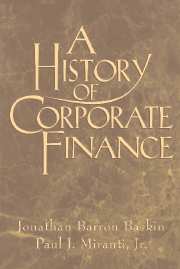Book contents
- Frontmatter
- Contents
- Preface
- Introduction: History and the Modern Theory of Finance
- Part I The Preindustrial World
- Part II The Rise of Modern Industry
- Part III The Transition to the Contemporary Era
- Epilogue
- APPENDIX A Finance and Informational Asymmetries in the Ancient World
- APPENDIX B International Patterns of Corporate Governance
- Index
APPENDIX A - Finance and Informational Asymmetries in the Ancient World
Published online by Cambridge University Press: 22 March 2010
- Frontmatter
- Contents
- Preface
- Introduction: History and the Modern Theory of Finance
- Part I The Preindustrial World
- Part II The Rise of Modern Industry
- Part III The Transition to the Contemporary Era
- Epilogue
- APPENDIX A Finance and Informational Asymmetries in the Ancient World
- APPENDIX B International Patterns of Corporate Governance
- Index
Summary
This appendix describes how businesses in ancient civilizations adjusted to the problems of financial risk. As in the medieval period, the greatest accumulations of wealth derived primarily from agriculture and trade. But the organizational innovations that bolstered the scale and scope of leading Italian business enterprises in the Middle Ages were lacking during antiquity. Instead, the largest and most important organizations during these early times were those of government. The following three sections identify several important institutions that were developed to reduce risk and increase the efficiency of financial transacting in the Babylonian, Greek and Roman periods.
Babylonian Beginnings
Babylonian civilization contributed three fundamental notions to the advancement of finance: (1) control of usury by interest-rate ceilings, (2) fixed-income obligations and defining the rights of creditors and (3) mortgage lending secured by liens on a wide array of chattels.
Economic surpluses created by irrigation agriculture provided a florescence of banking and commerce. By about 1800 B.C. the Code of Hammurabi began to formalize business and financial relationships regulating landownership and rental, agricultural employment, commercial transactions and loan contracts. In farming regions, grain, particularly barley, served as a medium of exchange. In urban centers, however, merchants both transacted and maintained their accounts using silver weights. Liquidity was enhanced through the maintenance of silver deposits at temples. Exchanges were evidenced at these locations through symbolic transfers of ownership.
The Code also standardized lending arrangements. For example, to be enforceable, all debt contracts had to be drawn up in the presence of an official witness. The law was also sensitive to the problem of usury. It stipulated a rate maximum of 20 percent on silver-based loans and 33.3 percent on grain loans.
- Type
- Chapter
- Information
- A History of Corporate Finance , pp. 313 - 321Publisher: Cambridge University PressPrint publication year: 1997



